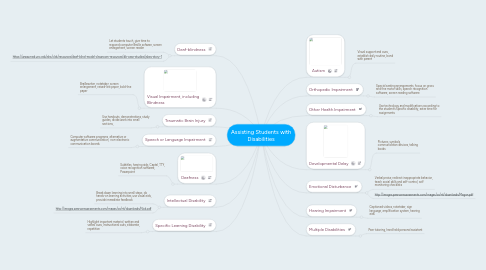Assisting Students with Disabilities
by J. Jackson

1. Autism
1.1. Visual support and cues, establish daily routine, bond with parent
2. Orthopedic Impairment
2.1. Special seating arrangements, focus on gross and fine motor skills, speech recognition software, screen reading software
3. Other Health Impairment
3.1. Use technology and modifications according to the student's specific disability, extra time for assignments
4. Deaf-blindness
4.1. Let students touch, give time to respond,computer Braille sofware, screen enlargement, screen reader
4.2. https://www.med.unc.edu/ahs/clds/resources/deaf-blind-model-classroom-resources/db-case-studies/jakes-story-1
5. Visual Impairment, including Blindness
5.1. Braillewriter, notetaker, screen enlargement, raised-line paper, bold-line paper
6. Traumatic Brain Injury
6.1. Use handouts, demonstrations, study guides, divide work into small sections,
7. Speech or Language Impairment
7.1. Computer software programs, alternative or augmentative communication, non-electronic communication boards
8. Deafness
8.1. Subtitles, hearing aids, Captel, TTY, voice recognition software, Powerpoint
9. Developmental Delay
9.1. Pictures, symbols, communication devices, talking books
10. Emotional Disturbance
10.1. Verbal praise, redirect inappropriate behavior, teach social skills and self-control, self monitoring checklists
10.2. http://images.pearsonassessments.com/images/ca/rti/downloads/Megan.pdf
11. Hearing Impairment
11.1. Captioned videos, notetaker, sign language, amplification system, hearing aids
12. Intellectual Disability
12.1. Break down learning into small steps, do hands-on learning activities, use visual aids, provide immediate feedback
12.2. http://images.pearsonassessments.com/images/ca/rti/downloads/Nick.pdf
13. Multiple Disabilities
13.1. Peer tutoring, hand held personal assistant
14. Specific Learning Disability
14.1. Highlight important material, written and verbal cues, instructional cues, elaborate, repetition


